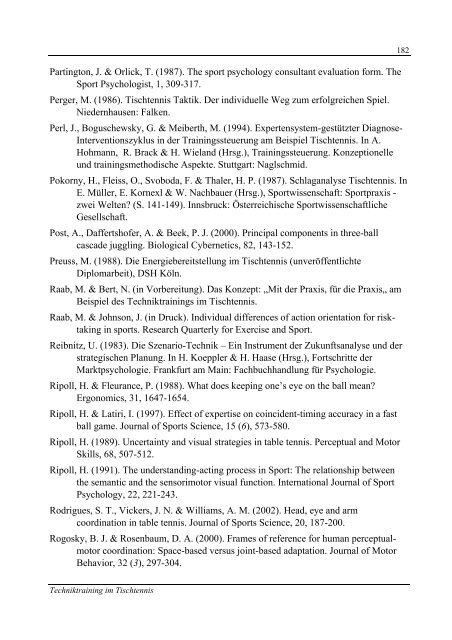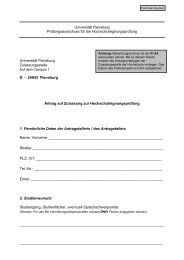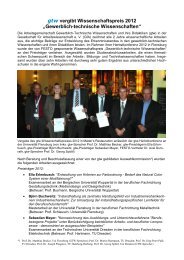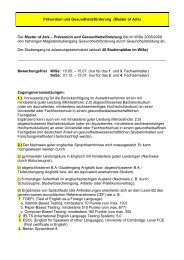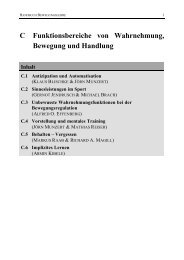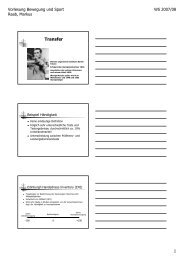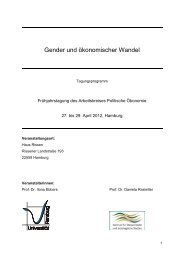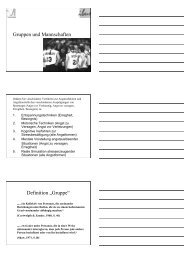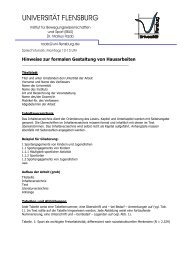Techniktraining im Tischtennis Intervention und Evaluation
Techniktraining im Tischtennis Intervention und Evaluation
Techniktraining im Tischtennis Intervention und Evaluation
Sie wollen auch ein ePaper? Erhöhen Sie die Reichweite Ihrer Titel.
YUMPU macht aus Druck-PDFs automatisch weboptimierte ePaper, die Google liebt.
Partington, J. & Orlick, T. (1987). The sport psychology consultant evaluation form. The<br />
Sport Psychologist, 1, 309-317.<br />
Perger, M. (1986). <strong>Tischtennis</strong> Taktik. Der individuelle Weg zum erfolgreichen Spiel.<br />
Niedernhausen: Falken.<br />
Perl, J., Boguschewsky, G. & Meiberth, M. (1994). Expertensystem-gestützter Diagnose-<br />
<strong>Intervention</strong>szyklus in der Trainingssteuerung am Beispiel <strong>Tischtennis</strong>. In A.<br />
Hohmann, R. Brack & H. Wieland (Hrsg.), Trainingssteuerung. Konzeptionelle<br />
<strong>und</strong> trainingsmethodische Aspekte. Stuttgart: Naglschmid.<br />
Pokorny, H., Fleiss, O., Svoboda, F. & Thaler, H. P. (1987). Schlaganalyse <strong>Tischtennis</strong>. In<br />
E. Müller, E. Kornexl & W. Nachbauer (Hrsg.), Sportwissenschaft: Sportpraxis -<br />
zwei Welten? (S. 141-149). Innsbruck: Österreichische Sportwissenschaftliche<br />
Gesellschaft.<br />
Post, A., Daffertshofer, A. & Beek, P. J. (2000). Principal components in three-ball<br />
cascade juggling. Biological Cybernetics, 82, 143-152.<br />
Preuss, M. (1988). Die Energiebereitstellung <strong>im</strong> <strong>Tischtennis</strong> (unveröffentlichte<br />
Diplomarbeit), DSH Köln.<br />
Raab, M. & Bert, N. (in Vorbereitung). Das Konzept: „Mit der Praxis, für die Praxis„ am<br />
Beispiel des <strong>Techniktraining</strong>s <strong>im</strong> <strong>Tischtennis</strong>.<br />
Raab, M. & Johnson, J. (in Druck). Individual differences of action orientation for risktaking<br />
in sports. Research Quarterly for Exercise and Sport.<br />
Reibnitz, U. (1983). Die Szenario-Technik – Ein Instrument der Zukunftsanalyse <strong>und</strong> der<br />
strategischen Planung. In H. Koeppler & H. Haase (Hrsg.), Fortschritte der<br />
Marktpsychologie. Frankfurt am Main: Fachbuchhandlung für Psychologie.<br />
Ripoll, H. & Fleurance, P. (1988). What does keeping one’s eye on the ball mean?<br />
Ergonomics, 31, 1647-1654.<br />
Ripoll, H. & Latiri, I. (1997). Effect of expertise on coincident-t<strong>im</strong>ing accuracy in a fast<br />
ball game. Journal of Sports Science, 15 (6), 573-580.<br />
Ripoll, H. (1989). Uncertainty and visual strategies in table tennis. Perceptual and Motor<br />
Skills, 68, 507-512.<br />
Ripoll, H. (1991). The <strong>und</strong>erstanding-acting process in Sport: The relationship between<br />
the semantic and the sensor<strong>im</strong>otor visual function. International Journal of Sport<br />
Psychology, 22, 221-243.<br />
Rodrigues, S. T., Vickers, J. N. & Williams, A. M. (2002). Head, eye and arm<br />
coordination in table tennis. Journal of Sports Science, 20, 187-200.<br />
Rogosky, B. J. & Rosenbaum, D. A. (2000). Frames of reference for human perceptualmotor<br />
coordination: Space-based versus joint-based adaptation. Journal of Motor<br />
Behavior, 32 (3), 297-304.<br />
<strong>Techniktraining</strong> <strong>im</strong> <strong>Tischtennis</strong><br />
182


